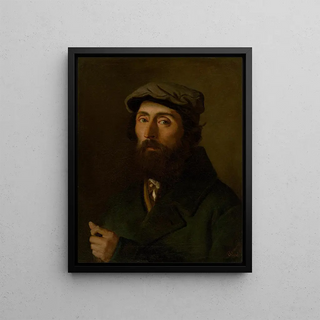Art print | Study of a Ghetto Man - Leopold Horowitz


View from behind

Frame (optional)
In the vibrant universe of art, some works transcend mere representation to offer a true immersion into the human soul. "Art print of a ghetto man study - Leopold Horowitz" is one of those creations that, through its depth and sensitivity, invites us to explore the realities of a often misunderstood world. This piece, both poignant and evocative, reminds us that art has the power to awaken consciences and evoke intense emotions. By contemplating this depiction, the viewer is transported to the heart of a visual narrative that portrays not only a human figure but also a social context rich with stories and struggles.
Style and uniqueness of the work
Leopold Horowitz's style stands out for its realistic and expressive approach, where each brushstroke seems charged with a profound intention. "Art print of a ghetto man study" captures with striking accuracy the features of the face and the expressions of its subject. The artist manages to convey a palpable atmosphere, where melancholy and resilience coexist. The subtle color nuances enhance this duality, creating a contrast between shadow and light that illustrates the challenges faced by individuals in difficult environments. The piece does not merely depict a man; it tells a story, that of a community, a culture, and an often overlooked identity by official history.
The artist and his influence
Leopold Horowitz, a prominent figure of 20th-century art, established himself through his unique perspective on the world around him. Born into a tumultuous context, the artist was deeply influenced by the historical events of his time, particularly those related to the Jewish diaspora and the realities of ghettos. His work, imbued with palpable humanity, testifies to an unceasing quest for truth and understanding. Horowitz was a pioneer in representing marginalized groups, using his art as a means to give voice to those who are often deprived of it. His legacy endures, inspiring many contemporary artists to explore similar themes, while continuing to question our relationship to others and

Matte finish

View from behind

Frame (optional)
In the vibrant universe of art, some works transcend mere representation to offer a true immersion into the human soul. "Art print of a ghetto man study - Leopold Horowitz" is one of those creations that, through its depth and sensitivity, invites us to explore the realities of a often misunderstood world. This piece, both poignant and evocative, reminds us that art has the power to awaken consciences and evoke intense emotions. By contemplating this depiction, the viewer is transported to the heart of a visual narrative that portrays not only a human figure but also a social context rich with stories and struggles.
Style and uniqueness of the work
Leopold Horowitz's style stands out for its realistic and expressive approach, where each brushstroke seems charged with a profound intention. "Art print of a ghetto man study" captures with striking accuracy the features of the face and the expressions of its subject. The artist manages to convey a palpable atmosphere, where melancholy and resilience coexist. The subtle color nuances enhance this duality, creating a contrast between shadow and light that illustrates the challenges faced by individuals in difficult environments. The piece does not merely depict a man; it tells a story, that of a community, a culture, and an often overlooked identity by official history.
The artist and his influence
Leopold Horowitz, a prominent figure of 20th-century art, established himself through his unique perspective on the world around him. Born into a tumultuous context, the artist was deeply influenced by the historical events of his time, particularly those related to the Jewish diaspora and the realities of ghettos. His work, imbued with palpable humanity, testifies to an unceasing quest for truth and understanding. Horowitz was a pioneer in representing marginalized groups, using his art as a means to give voice to those who are often deprived of it. His legacy endures, inspiring many contemporary artists to explore similar themes, while continuing to question our relationship to others and






